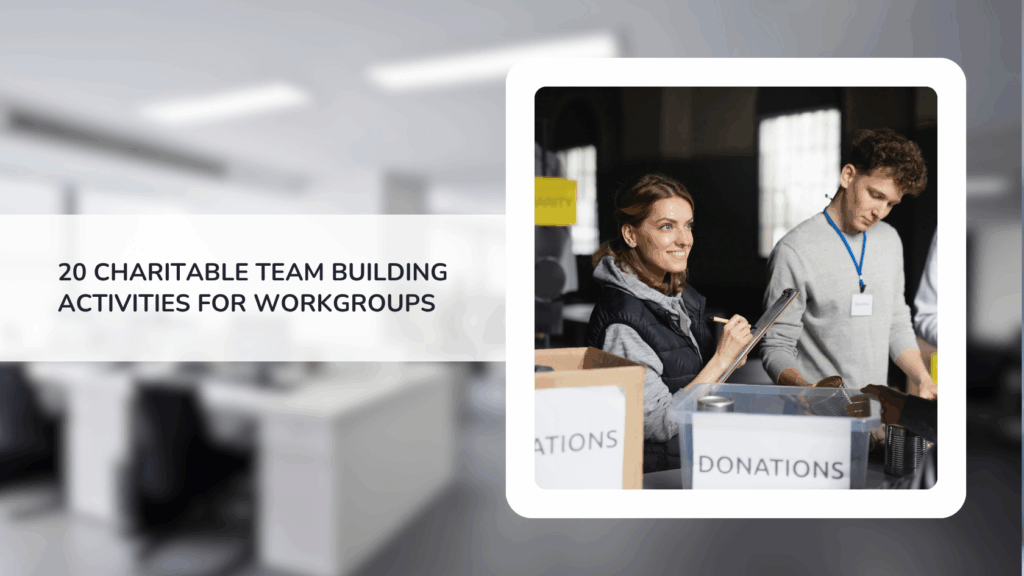
Planning icebreakers for large groups of corporate employees can be difficult. Whether you’ve got an entirely new team of colleagues you’re trying to help get acquainted, you’re looking for an engaging way to kick off a networking event, or you’re trying to get people ready for a meeting, an icebreaker activity might be exactly what you need.
You know the feeling. You’ve got a room full of people, all gathered for a common purpose, and yet there’s an overarching feeling of disconnectedness – even an awkward tension. Whether it’s a company retreat, an internal meeting, a networking event full of strangers, or a group of people waiting to take in a presentation, those first few moments of waiting around and getting going can feel a bit uncomfortable. In these situations, people might look down at their phones, gaze aimlessly around the room, or make small talk. And that’s because the reality is that, even for the most outgoing and extroverted people, a cold start to any gathering or event can be a challenge.
But here’s the good news: with the right type of icebreaker games, you can easily transform those awkward moments into fun, engaging, and productive ways to help people get comfortable and acquainted.
Here are three steps to follow to ensure you pick the perfect icebreaker activity for your large group.
Step 1: Identify the Group Dynamic
There are a ton of options available when it comes to picking icebreakers for large groups or even for small, intimate gatherings. The easiest way to decide which type will work best for your situation is based on your group’s dynamic:
- Find an Activity for Participants Who Know One Another – Icebreaker games are a great way to get the blood pumping and get a little excitement and energy going to kick off things like leadership meetings or company retreats. Even for people who are well acquainted, it never hurts to help people get loosened up. Doing so often makes it easier for people to participate more fully in the meeting.
- Pick an Icebreaker for Participants Who Don’t Know Each Other – There’s nothing better than an icebreaker activity when you’re working with a group of people who don’t know each other, such as at a networking event or presentation, or with a new team of employees who haven’t had time to build a rapport. The right icebreaker will encourage them to get a bit more comfortable and, in turn, help them get the most out of the event.
- Get Direct Insight into What People Want – When you’re in search of the right icebreaker for your group, it’s a great idea to gather insight about what type of activity the participants would be interested in or gain value from. For an internal work group, this could be something as simple as circulating a quick email with a few options. If you’re trying to find an icebreaker activity for a networking event or presentation, you could send a poll to your guests using a service like SurveyMonkey to see exactly what they want to get out of it, and then plan your activity to meet those needs.
Step 2: Decide What Your Goals Are
Icebreakers for large groups can be an effective way to achieve a number of goals. Picking the right activity will depend on what you’re hoping to get out of it. This can include:
- Helping People Get Acquainted – Sometimes, the best type of icebreaker is one that simply encourages people to get to know each other better on both a personal and professional level. These types of low-pressure activities are intended simply to stimulate conversation and spark new connections between people.
- Kicking-Starting or Breaking Up a Long Day in a Fun and Unique Way – Our customers often reach out to us in search of icebreaker games to kick-start a company retreat or a full day of meetings, or that would make a fun and energizing way to break up the day.
- Doing Something That Develops Key Skills – We often get inquiries about icebreakers for large groups that are doing an event targeted at developing key skills, such as communication and collaboration, and are in search of a fun and unique activity to incorporate into the day. With this type of icebreaker activity, the goal is to help people get to know each other a little bit better while also getting some tangible professional benefits from it as well.
Step 3: Pick the Right Team Building Event for Your Needs
Once you know what type of group you’re working with and have decided what you’re hoping to get out of your icebreaker games, the next step is to pick the right activity. At Outback Team Building & Training, we offer a number of fun and engaging icebreaker activities that can be done anywhere and for any group size. Here are three of our favorites:
- Team Pursuit – For groups who are in search of an icebreaker activity that will help people get acquainted while focusing on key skills, Team Pursuit is a great option. In this activity, colleagues will break into groups and tackle highly social mental, physical, and mystery challenges. To do so, they’ll need to exercise their communication, collaboration, and problem-solving skills – all while getting to know their colleagues in a new way. Team Pursuit is also an exciting way to reenergize your group during a long day of meetings.
- Getting to Know You – If you’re looking for the perfect icebreaker activity to help a group of people who have never met to get acquainted, then Getting to Know You is a great option. With this social scavenger hunt, participants will work through a selection of fun and exciting photo and video challenges which will require them to find people in the room who meet specific criteria. In order to find the right people, they’ll have to get proactive and ask questions that help them learn more about each other.
- Colleague Connections – For our company retreat last year, our leadership team created a brand-new icebreaker activity, called Colleague Connections, for our group to try in between sessions. In this activity, each employee spent five minutes speaking one-on-one with their colleagues, asking questions designed to help them learn more about each other, before moving on to a new colleague. By the end of the activity, each of our employees had spent five minutes chatting with everyone in the room. To learn more about Colleague Connections, including how it works as well as 50 sample questions you can use, check out our blog post.
Learn More About Icebreakers for Large Groups
For more information about how you can help people get to know each other with an icebreaker activity, just reach out to our Employee Engagement Consultants.



